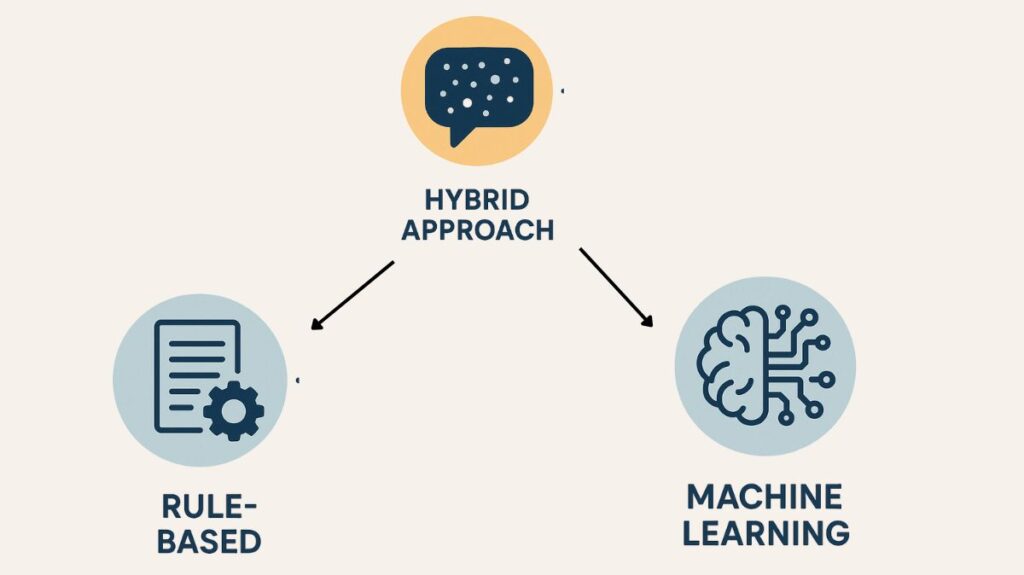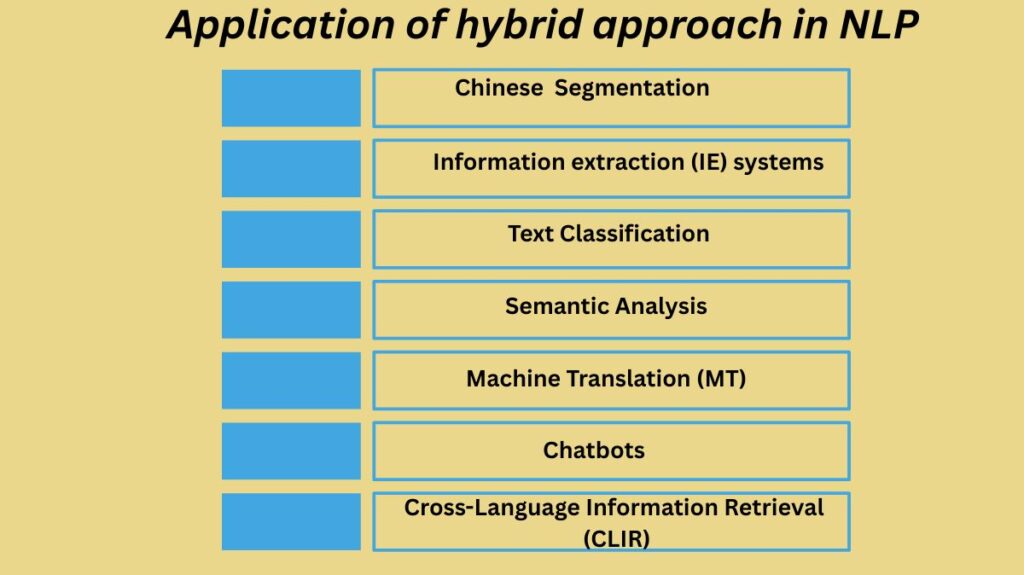What is the Hybrid Approach?
To improve performance on language tasks, natural language processing (NLP) uses a hybrid approach that blends rule-based and machine learning methods. In order to process language accurately in certain settings, the rule-based component depends on preset rules, grammar, and linguistic structures. In contrast, machine learning models can handle complicated, changeable language patterns and generalize because they learn from big datasets. In tasks like named entity identification, machine translation, and sentiment analysis, a hybrid strategy that combines these two approaches can improve accuracy, adaptability, and efficiency by utilizing their respective advantages.

A hybrid approach in natural language processing (NLP) usually combines aspects of many approaches to capitalise on their own advantages. Historically, there has been conflict in the discipline between statistical or corpus-based methods and symbolic (sometimes known as “classical” or “rule-based”) approaches. The creation of hybrid methods and applications that combined the best features of statistical and symbolic approaches was advocated by several scholars. Even if statistical techniques have taken over, earlier “classical” methods are still useful.
The understanding that neither simply statistical nor entirely symbolic approaches are ideal on their own serves as the driving force behind the adoption of hybrid approaches. Despite their potential for in-depth analysis, symbolic systems can be brittle and problematic with ambiguity, necessitating the laborious manual development of rules, which causes a bottleneck in the acquisition of knowledge. Statistical techniques that learn from data are frequently more reliable, generalise effectively, and handle errors and new data with grace. Hybrid techniques combine these principles to provide natural language processing systems that are more reliable and efficient.
Application of hybrid approach in NLP

Chinese Segmentation
The majority of earlier research in this field can be divided into three groups: hybrid, lexical rule-based, and statistical methods. Hybrid approaches combine manually encoded linguistic features used in lexical approaches, such as syntactic and semantic information, common phrasal structures, and morphological rules, with data from training corpora used in statistical methods (such as mutual information). Examples include a hybrid statistical-lexical technique that employs a trainable sequence of transformation rules for incremental segmentation improvement and a weighted finite-state transducer to identify dictionary entries and unknown words.
Information extraction (IE) systems
Hybrid, rule-based, or machine learning: Typically, hybrid techniques combine a machine learning system to identify more complicated items with a rule-based system to quickly identify entities that are easier to recognise.
Text Classification
Rule-based, machine, and hybrid systems are some of the methods used: Rule-based and machine-based techniques are combined in a hybrid text classification system. For example, it may generate an initial tag using a rule-based system, train the system using machine learning, and then generate rules.
Semantic Analysis
Semantic analysis employs hybrid methodologies. Distributional-compositional hybrids are one type. Representing a text by averaging its word embeddings which are calculated distributionally is a straightforward example. Thus, the composition of the distributional word embeddings is used to compute the sentence representation. In semantic representation, a “bottom-up” method entails giving already-existing distributed representations a minimal amount of symbolic structure. A set of distributional word clusters could be used in place of the specified vocabulary in a “top-down” method that begins with logical semantics.
Machine Translation (MT)
The distinction between rule-based and corpus-based approaches has become less clear as Chinese MT systems have advanced. It is typical for statistical systems to include language rules pertaining to syntax and semantics, and for rule-based systems to employ statistics for ranking rules.
Chatbots
Rule-based and neural/corpus systems can be combined to create hybrid chatbots. Even components of frame-based constructions may be included into them.
Cross-Language Information Retrieval (CLIR)/Alignment
Combining knowledge-rich sources like part-of-speech taggers and online dictionaries with knowledge-poor statistical approaches might be useful for tasks like matching brief texts in structurally diverse languages. In contrast to early Statistical NLP, this employs a variety of techniques and represents a shift towards a knowledge-rich approach.
Hybrid Approach Example
In natural language processing, or NLP, a hybrid solution usually blends two or more distinct approaches or techniques to address an issue. These techniques frequently leverage the advantages of both rule-based and machine learning methodologies. Here’s an illustration of how to use a hybrid technique for a particular NLP task:
A rule-based strategy Approaches
During the rule-based phase, possible named entities in text are found using pre-established rules or patterns. This could entail:
- Use regular expressions (Regex) to find particular patterns, such as phone numbers, dates, or monetary quantities.
- Dictionary-based matching to find well-known names of locations, businesses, or individuals.
Machine Learning Approaches
Following the rule-based stage, the entity recognition is improved using a machine learning model (such as CRF, LSTM, or Transformer) by:
- Categorizing more complicated or confusing situations where rules might not be enough (e.g., differentiating between a place name and a person’s name in some scenarios).
- Utilizing contextual information features of the surrounding words that are not captured by straightforward rules.
Combining the Two Approaches
The rule-based system is utilized in the hybrid approach to quickly and simply identify entities that are simple to identify. After that, more complicated or unclear entities are resolved using the machine learning model.
Particularly when working with complicated and less structured data, this hybrid method benefits from the accuracy and flexibility of machine learning models as well as the efficiency and speed of rule-based systems.
